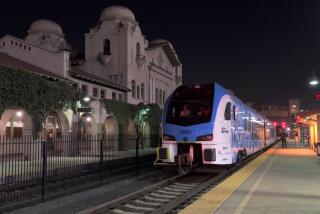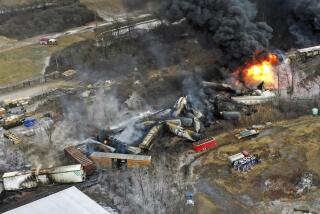Years of use prove rail controls work
During the evening rush hour on March 25, a runaway freight car weighing 112 tons hurtled down the tracks toward a Massachusetts commuter train loaded with 300 passengers.
As the freight car closed in at 30 mph, the commuter train suddenly braked to a stop, not by any action of its engineer, but because of an automated system designed to sense another train on the tracks.
The freight car slammed into the commuter train’s locomotive, and 150 passengers suffered minor injuries. But officials with the Massachusetts Bay Transit Authority say the crash would have been much worse had the commuter line not been equipped with an automatic braking system -- a system that has been in place and improved upon for years.
In the aftermath of the Sept. 12 crash in Chatsworth that took the lives of at least 25 people and injured 135, Metrolink officials repeatedly have said that such controls have not yet been perfected to the point where they can be installed throughout Southern California’s rail system, where 66% of the tracks are shared by freight and passenger trains.
But as the Massachusetts case indicates, control systems have been installed in several places around the country where they have worked effectively. Safety officials say that positive train controls, which are designed to stop a train automatically if an engineer goes through a red signal or if sensors detect another train on the tracks, could have prevented the Chatsworth crash or reduced its impact.
Though the cause of the accident is under investigation, preliminary findings suggest that the Metrolink engineer missed a stop signal and failed to wait on a side track for the freight train to pass.
Positive train controls have been installed on railroads for almost 90 years in the United States. They were first required by the Interstate Commerce Commission in 1920, when 49 railroads were ordered to install train stop systems on some passenger lines.
In 1937, Congress, reacting to a rash of passenger train wrecks, ordered railroads to install automatic train stop systems in high-risk corridors.
But because of the dramatic decline in train travel in the U.S., many of the systems were removed with the approval of the Interstate Commerce Commission, which became the Federal Railroad Administration in 1967.
“Positive train control is not a new concept, nor a new technology,” said George Gavalla, the former head of the Federal Railroad Administration’s safety office, where he worked from 1995 to 2004. “That accident would not have happened had they invested in a system that can detect a train going through a signal,” he said, referring to Metrolink.
Francisco Oaxaca, a spokesman for Metrolink, said the only part of the agency’s 388 miles of track that has automatic braking is a stretch in south Orange County that was equipped with the system by another railroad before Metrolink began operation in 1992. Oaxaca said Metrolink officials were not prepared Friday to say anything more about rail safety measures.
Positive train controls range in complexity from sensors and automatic braking systems to sophisticated designs that rely on Global Positioning System technology, computers and digital radio communications.
Cab signals, a system that has been used for decades on trains, are one of the simplest safety devices. Operated by electricity, a cab-mounted display tells engineers what a signal is in advance so they can prepare for it. The signals communicate with trains through wires in the track bed.
Another device that has long been available is automatic or positive train stop, a mechanical and electronic system that activates the brakes if a train proceeds through a stop signal. The brakes are set by a lever or bar in the tracks.
Amtrak and the Massachusetts Bay Transit Authority have combined automatic train stop with cab signals and track sensors. More sophisticated systems employ Global Positioning System technology to monitor train locations and speeds; sensors and computers to gather and analyze data; remote control equipment for engines; and advanced digital radios to communicate with trains, signals and dispatchers.
The most complex systems, which have been under study for more than 20 years, can detect speed-limit violations, improperly aligned switches, unauthorized train movements and whether trains are on the wrong track or have missed signals.
Grady Cothen, a deputy associate administrator of safety at the railroad administration, said that in the last 40 years the railroad administration has been trying to preserve and improve the systems that exist scattered across the country.
Today, upgraded versions of the older systems can be found on commuter railroads, Amtrak routes and parts of freight lines around the U.S. Similar systems have been widely used for decades in Japan and Europe, where a uniform system is being developed across the continent that incorporates the latest technology.
In the U.S., demonstration projects using advanced positive train controls are underway at nine railroads in 16 states. Railroad administration officials say some technical problems and cost issues need to be resolved before a national system is created.
“You can apply the systems regionally, but the railroads want” a uniform system nationally, Cothen said. “The major freight carriers have settled on the technology. We will all be on the same page very shortly. We will lick this and get it done.”
Sophisticated systems have been operating successfully for almost a decade on Amtrak lines in southwest Michigan and on parts of the Northeast Corridor between Washington and New York, as well as between Boston and New Haven, Conn. Passenger and freight trains use the lines.
In 2000, Amtrak and the Michigan Department of Transportation began operating an advanced train control system along 40 miles of track between Chicago and Detroit. Another 20 miles is scheduled to be added in the months ahead. So far, the system has cost about $40 million.
“They have been very effective,” said Cliff Black, an Amtrak spokesman. “We haven’t had any major technical problems. The systems permit you to operate trains at high speeds close to each other.”
The NTSB made the first recommendations for positive train control more than 30 years ago. In 1990, the NTSB added the technology to its list of 10 most wanted safety improvements.
In the last 10 years, the agency has investigated 52 serious rail accidents, including four transit accidents that probably would have been prevented with the installation of a positive train control system. The NTSB had fatality and injury data for 29 of the 52 accidents. In those accidents, 37 people were killed and 595 were injured.
In August 1999, the federal Railroad Safety Advisory Committee issued a report stating that out of a sample of 6,400 train accidents of all types, 2,659 accidents could have been prevented had some form of positive train control been implemented.
Agency officials say they have been frustrated about what they consider to be the slow pace of developing and applying positive train control technology around the country. They blame a failure of leadership in Washington and the railroad industry, which views positive train control as an expensive add-on.
“We have the technology,” said Jim Hall, who chaired the NTSB from 1994 to 2001. “But we don’t have the will.”
--
--
(BEGIN TEXT OF INFOBOX)
Hospital report
* 86 Metrolink riders were hospitalized after the Sept. 12 crash
* 20 were still hospitalized Sunday
* 4 were in critical condition
* 2 were in serious condition
* 3 were in stable condition
* 11 were in fair or good condition
Source: Times research
More to Read
Sign up for Essential California
The most important California stories and recommendations in your inbox every morning.
You may occasionally receive promotional content from the Los Angeles Times.











